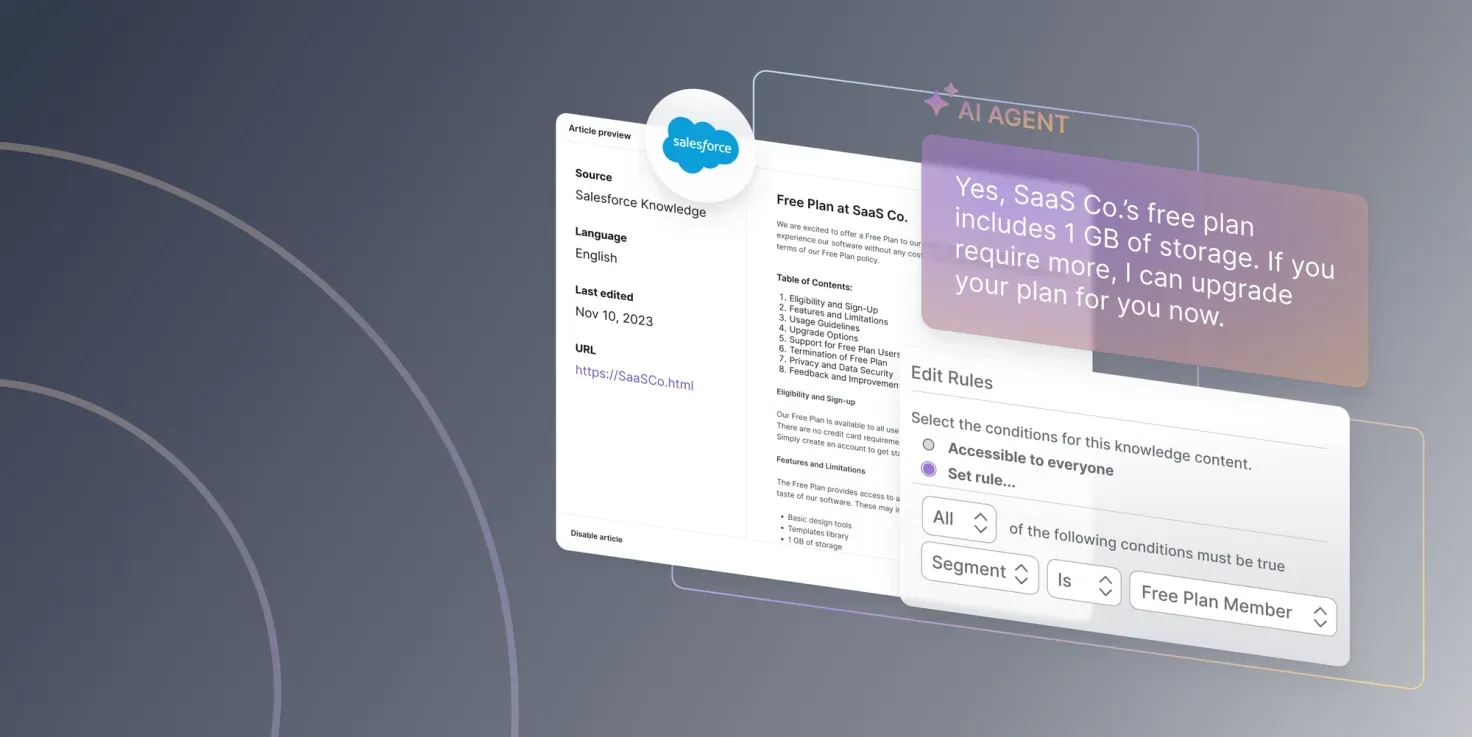
Guide to building vs. buying an AI Agent for customer service
This guide will help you assess the build vs buy question from 5 main angles so you can make a confident, informed decision.
Learn More

We talk a lot about the benefits of using AI in customer service — and we genuinely believe in them — but AI isn’t a shiny new toy that will solve all your problems overnight.
The conversational AI market’s value is expected to reach $33 billion by 2030, but 70% of consumers still prefer human agents to AI for customer service interactions. Ouch. That's a pretty clear sign that we've got some work to do.
Businesses are navigating complex terrain to harness AI’s full potential. When done right, AI can be a game-changer. It can drive revenue growth and cut operational costs. It can increase customer lifetime value (CLTV) and strengthen brand reputation. And it can put you ahead of the competition. In fact, companies that offer AI customer service grow in revenue 4-8% faster .
28% of business leaders have used AI to cut their company’s costs.
- Tidio
But in order to achieve AI greatness, the right implementation of AI customer service is crucial.
Here are five pitfalls of AI customer service that you need to be aware of. And don't worry, we're not just here to point out the problems. We're also going to show you how to sidestep these landmines so your business can create a customer service ecosystem that leverages AI’s strengths to deliver best-in-class experience.
Picture this: You're chatting with what you think is a human customer service agent. The conversation is going smoothly, but something feels... off. Suddenly, you realize you're talking to AI.
The concept of the “uncanny valley” in AI refers to when AI responses that are almost, but not quite, human-like create a sense of unease or discomfort. And it can leave a bad taste in your customers’ mouths.
So, how do we avoid this AI identity crisis? Embrace AI’s identity instead. You can craft a greeting message that clearly communicates that the person is talking to AI but also increases trust in the AI by outlining the its capabilities. For example:
“Hey! I’m Wall-E, an AI Assistant for Acme Industries. I’m able to answer thousands of common questions about our products and help you make updates to your account, including billing issues.”
The goal is to:
To do this, the AI needs to be capable of behaving like a human agent. You need an AI agent that actually reasons through problems like a human would. An AI agent that instantly connects to your knowledge sources to act autonomously, perform complex actions, and follows brand guidelines to act as an ambassador for the business.
Over two-thirds of CX organizations think generative AI will help them provide warmth and familiarity in customer service.
- Zendesk
Ever feel like you're stuck in a time loop, repeating the same conversation over and over? It's like being trapped in a customer service version of "Groundhog Day" — without the charm of Bill Murray on the other end of the interaction.
When an AI system fails to understand or appropriately respond, it leaves customers feeling unheard and unvalued, which is exactly what you don’t want your customers to feel after interacting with your business.
While 90% of businesses report faster complaint resolution with AI, it becomes meaningless if it's acting like a dog chasing its own tail.
To mitigate the risk of conversational loops, organizations should implement two key strategies:
Take the guesswork out of your AI strategy. This guide will help you assess the build vs buy question from 5 main angles so you can make a confident, informed decision
Get the guideEmotions, those pesky little things that make us human. Unfortunately, they're also the Achilles' heel of many AI systems.
Emotional intelligence is one of the most challenging aspects for AI systems to replicate convincingly, but it’s also a critical component of delivering effective customer service.
Positive experiences with AI customer support elevates buyer satisfaction by up to 20%.
- Tidio
Without proper emotional intelligence capabilities, AI agents fail to recognize the emotional context of customer interactions, and this could hurt your brand reputation. Your AI agent could come off as cold, inappropriate, or even offensive, particularly in situations where empathy and understanding are crucial.
To address this pitfall organizations should focus on two key areas:
In the rush to embrace AI, some companies fall into the trap of over-automating their customer service processes. The result? A depersonalized experience that fails to meet the nuanced needs of individual customers.
A customer experience that’s impersonal and inflexible makes it impossible to solve complex issues, especially when empathy and judgment are essential
Businesses should go for a balanced and incremental approach to AI implementation.
Poor integration with existing systems can severely limit AI’s capabilities and effectiveness.
Imagine this: Your new AI customer service solution is up and running. It's sleek, it's smart, it's... completely disconnected from all your other systems. Congratulations, you've just created the customer service equivalent of a desert island.
When AI is operating in silos, disconnected from other businesses tools and databases, it has limited information. And it’s likely to serve up incomplete or inaccurate responses to customer queries, requiring customers to repeat information or navigate multiple systems to resolve their issues. It completely undermines the potential benefits of AI implementation.

Your AI should be able to pull information from all the systems your human agents use. Here’s what to look for in an AI customer service solution:
Interested in harnessing the full potential of AI in your customer service? Understanding and proactively avoiding these five key pitfalls can save you a ton of grief in your implementation.
One major takeaway here is that it’s crucial to maintain a balance between technological innovation and human oversight. You need to strike the balance — your AI customer service depends on it.
Implementing AI in customer service can feel like you're navigating the open ocean without a compass, unless you have the right AI agent platform on your side. Choose wisely.
Find out how AI agents can unlock better customer experiences and ladder up to your business goals.
Get the guide